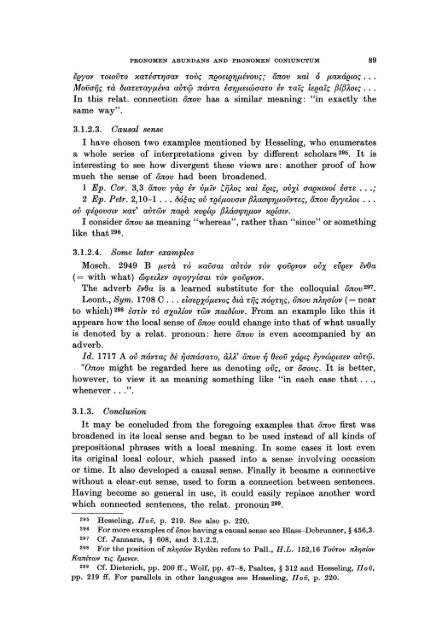Pronomen Abundans and Pronomen Coniunctum. A ... - DWC
Pronomen Abundans and Pronomen Coniunctum. A ... - DWC
Pronomen Abundans and Pronomen Coniunctum. A ... - DWC
You also want an ePaper? Increase the reach of your titles
YUMPU automatically turns print PDFs into web optimized ePapers that Google loves.
PRONOMEN ABUNDANS AND PRONOMEN CONIUNCTUM 89<br />
iieyov 'WtovrO "adaTrwav rovç neOete'YJ/.lÉVOVç; onov "al. Ó /.la"áetoç .. .<br />
Movaijç rà btareraY/.lÉva avnp návra Èa'YJ/.leu»aar:o èv raiç [eeaiç (3{(3ÀOtç . . .<br />
In this relat. connection onov has a similar meaning: "in exactly the<br />
same way".<br />
3.1.2.3. Causal sense<br />
I have chosen two examples mentioned by Hesseling, who enumerates<br />
a whole series of interpretations given by different scholars 295. It is<br />
interesting to see how divergent these views are: another proof of how<br />
much the sense of onov had been broadened.<br />
1 Ep. Cor. 3,3 onov yàe Èv v/.liv CijÀoç "al. iietç, ovXl. aU(!"t"o{ Èare ... ;<br />
2 Ep. Petr. 2,10-1 ... c5ó~aç ov reÉ/.lOvatv (3Àaaf{J'YJ/.l0vvreç, onovayyeÀot .. .<br />
ov f{JÉeOVatV "al" avnvv naeà "ve{cp (3).áaf{J'YJ/.lov "e{atv.<br />
I consider onov as meaning "whereas", rather than "since" or something<br />
like that 296.<br />
3.1.2.4. Some later examples<br />
Mosch. 2949 B /.le7:à Ta "avaat avrov .av f{Jovevov ovx e'Ûeev iivOa<br />
(= with what) wf{JetÀev af{Joyy{aat .av f{Jovevov.<br />
The adverb ii1l0a is a learned substitute for the colloquial onov 297.<br />
Leont., Sym. 1708 C ... elaeeXó/.le1loç ótà rijç nÓeT'YJç, onov nÀ'YJa{ov (= ne ar<br />
to which) 298 Èaû1I ra aX0).{o1l ruw natbtw1I. From an example like this it<br />
appears how the local sense of onov could change into that of what usually<br />
is denoted by arelat. pronoun: here onov is even accompanied by an<br />
adverb.<br />
Id. 1717 A ov návraç ói rwnáaaTo, àÀ).' onov f; Oeov xáetç Èyvwetaev avnp.<br />
"Onov might be regarded here as denoting ovç, or oaovç. It is better,<br />
however, to view it as meaning something like "in each case that ... ,<br />
whenever ... ".<br />
3.1.3. Conclusion<br />
It may be concluded from the foregoing examples that onov first was<br />
broadened in its local sense <strong>and</strong> began to be used instead of all kinds of<br />
prepositional phrases with alocal meaning. In some cases it lost even<br />
its original local colour, which passed into a sense involving occasion<br />
or time. It also developed a causal sense. Finally it became a connective<br />
without a clear-cut sense, used to form a connection bet ween sentences.<br />
Having become so general in use, it could easily replace another word<br />
which connected sentences, the relat. pronoun 299.<br />
295 Hesseling, IIov, p. 219. See also p. 220.<br />
296 For more examples of ö;nov having a causal sense see Blass-Debrunner, § 456,3.<br />
297 Cf. Jannaris, § 608, <strong>and</strong> 3.1.2.2.<br />
298 For the position of :n;).TJGlov Rydèn refers to PaU., H.L. 152,16 ToVrov n).TJulov<br />
KU7T.LTWV TtÇ l,.,.evev.<br />
299 Cf. Dieterich, pp. 200 ff., Wolf, pp. 47-8, Psaltes, § 312 <strong>and</strong> Hesseling, IIov,<br />
pp. 219 ff. For parallels in other languages see Hesseling, Ilo v, p. 220.
















